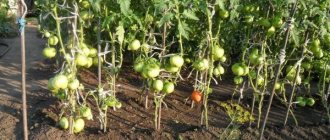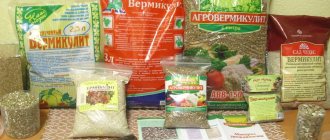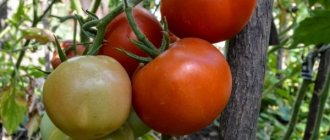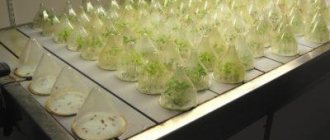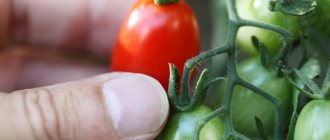Some summer residents complain that cucumbers and tomatoes on their plots yield almost no harvest. Others say that the flowers bloom reluctantly and the inflorescences are too small. Do you think these are problems from different planes? But no. If you have just started your summer cottage career and recently bought a plot of land, we recommend that you study the soil. Your task is to measure the pH of the soil on the site, and only after that start planting flora representatives. The fact is that if the soil is too acidic, not all plants will be able to grow and bear fruit in it. Today we will talk about those who love acidic soil, as well as what to do to deoxidize the soil if necessary.
What is pH and its meaning
Aluminum and hydrogen ions oxidize the earth, then it begins to show signs of acids in its composition. The more hydrogen ions there are in the soil, the more acidic it will be. Acidity indicators are denoted by the term pH, which means the decimal power of the reciprocal of the level of hydrogen ions (H+) - from 0 to 14. Neutral is acidity with indicators pH 7.0, below neutral acidity the soil will be acidic, above neutral it will be alkaline. So, soil acidity is a hydrogen indicator of the quality of the earth.
It is important to know. If the soil contains manganese, iron, copper and zinc, it will be acidic, and if there is sulfur, molybdenum, calcium and potassium, it will be alkaline. An acidic environment dissolves iron, zinc, boron, phosphorus and manganese well. High oxidation or alkalization inhibits plant development.
Each crop needs optimal soil acid-base balance (pH) values at which it will best develop, bloom and bear fruit.
Classification of acidic soils
pH indicators that are classified as soils:
- the most acidic – 3.8 – 4.0;
- strongly acidic – 4.1 – 4.5;
- medium acid – 4.6 – 5.0;
- slightly acidic – 5.1 – 5.5;
- close to neutral soil – 5.6 – 6.9.
Classification of alkaline soils
pH indicators that are classified as soils:
- the most alkaline – 11 – 14;
- highly alkaline – 10;
- alkaline – 9;
- slightly alkaline – 8;
- neutral – 7.
Why does the acidity of the soil environment change?
A slightly acidic or neutral soil environment with a pH of 5-7 is suitable for many crops. But the formation of soil acidity occurs from the influence of the chemical composition of the material in it. For example, if it is calcareous shales or soil with limestone, then the pH will initially have high alkali values. For the soil to become acidic, a lot of time must pass, longer than it would take for sandstones or soils formed on granites. The geological age of the earth also affects the acid-base balance, as well as annual precipitation: water evaporation and residual moisture. When moisture accumulates in the ground, soluble salts and minerals are leached, which increases the acidity of the soil within the plant roots.
Each harvest removes calcium, potassium and magnesium from the soil, making it more acidic. In wet soils, organic material tends to decompose, which also increases acid levels, especially carbonic acid. If there is little oxygen in wet soil, carbon dioxide will react with water and form carbonic acid. It takes a long time for pH values to change naturally. You can speed up this process yourself, that is, manually.
What vegetables don't like fresh manure?
Root crops and manure...
There is an irrefutable truth in agriculture: manure is an unrivaled fertilizer. No, there has never been and never will be a fertilizer equal to its importance for the fertility of the earth and for the harvest.
However, is it always possible to apply it to all crops? It turns out that the passion for manure when cultivating vegetable crops turns out to be not good, but evil for them. And especially then manure plays a negative role when it is introduced into the soil unrotted and straw-like.
Thus, carrots sown on fresh soil suffer greatly from excess carbon dioxide released during the decomposition of straw residues. The skin of carrots is tender and easily vulnerable. The developing root crop, encountering the still unrotted remains of straw, is injured and branches, forming chimera roots, freaks. As a rule, such carrots grow non-standard, do not have a marketable appearance, the yield decreases, and most of it goes to waste. Therefore, you need to sow carrots in an area where fertilizers were applied to the previous crop.
They do not like fresh manure onions, beets, garlic, radishes, radishes, that is, those crops that form a harvest underground, because their roots and bulbs, when encountering solid particles, are deformed, bent, and branched. You should not use this organic fertilizer directly for the cultivation of bracolli cabbage, savoy cabbage, blue cabbage, since the quality of the products from such a procedure sharply decreases and the taste is lost. They bear fruit more abundantly and produce excellent-tasting products if organic matter was applied a year before their cultivation.
How to adjust acidity
With the long-term cultivation of fruit trees and bushes, agricultural crops with the regular use of fertilizers and mineral complexes, the composition of the soil in different areas of the garden and garden and pH values change. The environment at the roots of plants will tend to oxidize, especially during acidic precipitation in the summer, due to disturbances in the global ecology.
We give recommendations on how to reduce or increase the acidity of the soil in the garden. To correct acidity, the following work is carried out :
- apply fertilizers, calcium and sodium nitrate, urea (urea), nitroammophoska, dilute the soil with another fertile soil mixture, replace the top layer of soil - to reduce the indicators;
- superphosphate, potassium sulfate, potassium salt are added to improve performance.
To increase the alkali in the soil, liming is carried out. And in order to choose the right dose, you need to know the oxidation state indicators.
Soil deoxidation is carried out in spring and autumn:
1. Lime: slaked fluff, tuff (key lime), drywall (lake lime), cement dust, ground limestone (carbonic lime) and other substances.
It must be remembered that lime is aggressive, so plants may not absorb phosphorus for some time. It is preferable to apply a deoxidizer during digging in the fall, then by spring the chemical processes in the soil will come into balance. It is necessary to add fluff lime (kg/m2):
- sour – 0.5;
- medium acidity – 0.3;
- slightly acidic – 0.2.
Ground limestone will be needed for soils (kg/m2):
- light loams and sandy loams: acidic – 0.35-0.4, medium – 0.25-0.3, slightly acidic – 0.2;
- medium and heavy loams: acidic - 0.55-0.6, medium - 0.45-0.5, slightly acidic - 0.35 - 0.4.
2. Dolomite flour - crushed rock - dolomite.
It is applied both in the spring when planting plants, and in the fall when digging up the ground. Dolomite flour contains a lot of magnesium; light soils require it. It loosens viscous clay soils well, improves their composition and structure. Dolomite is necessary for soils (kg/m2):
- sour – 0.5;
- medium – 0.4;
- slightly acidic – 0.3-0.4.
3. Wood ash – a natural fertilizer.
Depending on the type of tree, its age and place of growth, calcium salts in the ash are contained in different quantities - 30-60%. Therefore, the rates of ash application are small, and in order to fully deoxidize the soil you need 1-1.5 kg/m2. There are not many tree branches to burn on the plots, so dry grass and weeds are burned. Such ash is added at 2.5 kg/m2. It is used as a fertilizer due to its calcium, phosphorus, and magnesium content.
4. Gypsum - a white or yellow calcareous mineral substance from the sulfate class.
It dissolves in the soil thanks to acids, not water. By reacting with them, gypsum lowers the pH to normal and enters a passive state. When the acidification level increases, it becomes active again and continues the reaction. Required amount of gypsum for soils (kg/m2):
- sour – 0.4;
- medium – 0.3;
- slightly acidic – 0.1 – 0.2.
5. Chalk – soft white limestone.
It is thoroughly crushed and added to the ground before digging in the fall. Chalk is afraid of moisture, so you need to mix it well with the soil so that there are no lumps. Required amount of chalk flour for soils (kg/m2):
- sour – 0.5-0.7;
- medium – 0.4;
- weak – 0.2-0.3.
We will describe the soil pH indicators for plants in more detail in the table below.
Soil deoxidation
The composition of the soil is different everywhere, and the acidity level also varies, which has a direct impact on the survival rate of plants. Acidic soil is characterized by the transition of microelements into various states, due to which many of them become difficult to access for plants, while others acquire a toxic form. So, if you plant an unadapted plant in acidic soil, you can observe signs of chlorosis and a lack of growth and flowering. Such soils are heavier, have poorer air permeability, and often become waterlogged.
Important! How to measure soil acidity using instruments and available tools can be read in this material.
Weeds that grow most actively can tell you how acidic the soil is. These are the so-called acidophiles - plants of acidic soils. If you diligently control sedge in your area, mosses thrive in the shade, and plantains, horsetails and horse sorrel multiply in the sun, probably a pH indicator. in the area is reduced.
If the ph level. below 5, then such soil requires deoxidation. You can adjust the indicators using fertilizers and organic matter. Read more…
- It is advisable to choose calcium and phosphorus mixtures as fertilizers, since it is these microelements that plants in an acidic environment are sorely lacking. Good results are achieved by adding calcium nitrate, or superphosphate. Other deficient microelements include manganese, molybdenum, magnesium, and copper. But keep in mind that a visible effect can only be achieved over time if you regularly replenish the mineral reserves of the soil. How and when to fertilize? The article garden fertilizers will answer these questions.
- If you are just planning to create a flowerbed or bed on your site, you can prepare the soil by planting green manure - crops that improve the structure of the soil and enrich it with nitrogen. For acidic soils these are: legumes, rye, oats, vetch, phacelia. Once they have served their purpose, they can be used as mulch.
- Soil deoxidation by isolating - adding ash is considered one of the safest and most useful methods. In addition to alkalization, ash itself is a source of valuable elements. Application rate – 0.2 kg. 1 sq.m.
- To improve acidic soil, liming is used - adding slaked fluff lime to the surface layer of soil. This method is suitable for heavy clay soils, and even then only for digging. The approximate application rate is 0.2-0.5 kg. 1 sq.m. depending on the acidity level.
- If deoxidation is carried out on light sandy soil, you can use dolomite flour and chalk, which, in addition to alkalization, enrich the soil with calcium and magnesium. Application rate – 0.2-0.3 kg. 1 sq.m.
✿
How to quickly determine pH
Farmers take soil samples to the laboratory or purchase a pH meter - a device for measuring the level of acids that appear in the soil solution. But this method is extremely inconvenient due to the need to dissolve handfuls of soil in distilled water, and remove soil samples from a depth of 6 cm. In addition, you need to check the soil in the garden in different places, taking samples 5 times at intervals of up to 30 cm.
Since you need to check the acidity of the soil at home quickly and without unnecessary hassles , gardeners use acmus strips, phenolphthalein and methyl orange . These test substances change color in an acidic environment.
It is important to know. All types and varieties of cabbage, beets, garlic and onions feel comfortable in neutral soils. Zucchini, cucumbers, eggplants, peas and potatoes prefer slightly acidic areas. An acidic environment is ideal for pumpkins, carrots and tomatoes.
Ordinary table vinegar will help to carry out a test , for which a handful of earth (1 tsp) is poured with a few drops of liquid on the glass. Bubbles and hissing will appear upon contact with an alkaline medium; if they do not exist, then it is acidic.
You can use red cabbage for the dough. Then the soil solution is filtered using distilled water. Squeeze the juice out of the cabbage and add a few drops of alcohol to it. The solution and cabbage-alcohol liquid are combined. If the color of the tester becomes more scarlet, the soil is acidic; if it turns blue or purple, the substrate is alkaline.
10 blackcurrant leaves you can determine the environment of the earth . In an acidic environment, the infusion will turn red, in a neutral environment it will turn bluish, and in a slightly acidic environment it will turn green.
Weeds also respond to pH, so they can be used to judge which environment is more comfortable for them. Namely:
- in an acidic environment there will be a lot of growth of nettle , creeping buttercup, heather, plantain, common and horse sorrel, pike and pickerel, white and sorrel, buttercup, popovnik, sphagnum and green mosses;
- in a slightly acidic environment you will have to fight with clover, field birch, coltsfoot, odorless chamomile, plantain, dog violet and meadow cornflower;
- a neutral environment is suitable for field bindweed, spring Adonis (adonis), white clover, and sow thistle;
- alkaline - a comfortable environment for white dormancy, field mustard, larkspur and poppy .
Consider the table of soil acidity for plants ( table ):
| 5,3-6,0 | For acidophiles | For plants growing in acidic soil |
| 6,0-7,2 | For neutrophils | For plants that prefer a neutral environment |
| 7,3-8,1 | For basiphiles | For plants that prefer an alkaline environment |
A neutral or slightly alkaline reaction (pH 6.6-7.0) in the soil is suitable for plants: white cabbage and other varieties: parsnips, onions, peppers, beets, celery, asparagus.
A slightly acidic reaction (pH 6.3-6.7) is suitable for plants: beans and eggplants, peas, melons and zucchini, kale, potatoes, lagenaria and loofah, cucumbers, lettuce and beans, spinach. Neutral or slightly acidic soil is loved by garden flowers : roses, primroses, gillyflowers and chrysanthemums.
What plants love acidic soil (list):
- vegetables - potatoes, carrots, radishes, turnips, tomatoes, pumpkin, sorrel;
- berries – lingonberries, blueberries, strawberries, cranberries;
- herbs and flowers - azalea, evergreen erica, heather and hydrangea, rhododendrons and ferns, chicory and conifers.
Any flowers in containers
Many annuals grow well in a variety of containers, and this is another option for creating a beautiful flower garden in acidic soils. Lobelias, petunias, begonias, pansies, low-growing marigolds and many other flowers create real fireworks of bright colors. Ampelous, creeping or bush forms will find their place in any flower arrangement, and you will prepare the soil for them individually.
Another advantage of growing flowers in containers is that you can always remove fading plants and put new ones in their place. And you can do this starting in early spring - after all, tulips, muscari, and hyacinths feel great in pots.
Dear readers! The popular wisdom is right - there are no bad areas, there are unique conditions. And you can adapt to these conditions - you just need to study the features of the territory and show a little knowledge, work and imagination.
